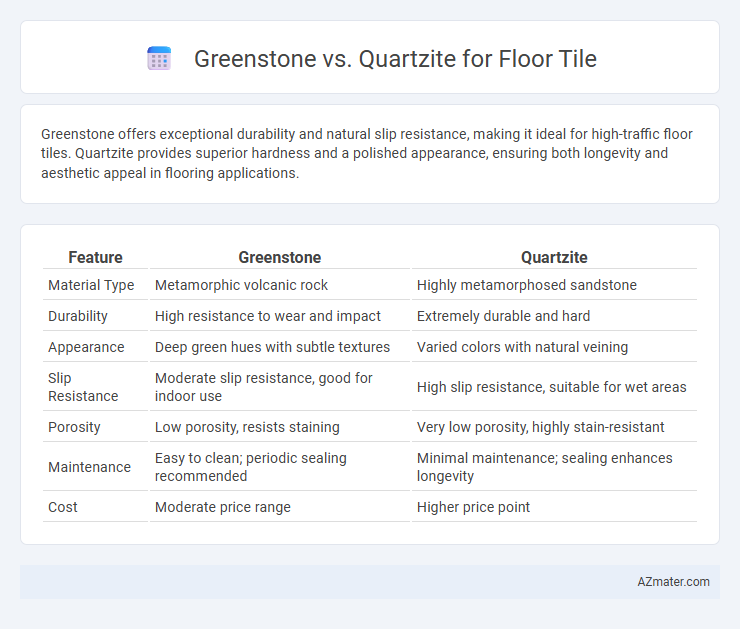Greenstone offers exceptional durability and natural slip resistance, making it ideal for high-traffic floor tiles. Quartzite provides superior hardness and a polished appearance, ensuring both longevity and aesthetic appeal in flooring applications.
Table of Comparison
| Feature | Greenstone | Quartzite |
|---|---|---|
| Material Type | Metamorphic volcanic rock | Highly metamorphosed sandstone |
| Durability | High resistance to wear and impact | Extremely durable and hard |
| Appearance | Deep green hues with subtle textures | Varied colors with natural veining |
| Slip Resistance | Moderate slip resistance, good for indoor use | High slip resistance, suitable for wet areas |
| Porosity | Low porosity, resists staining | Very low porosity, highly stain-resistant |
| Maintenance | Easy to clean; periodic sealing recommended | Minimal maintenance; sealing enhances longevity |
| Cost | Moderate price range | Higher price point |
Introduction to Greenstone and Quartzite Floor Tiles
Greenstone and quartzite floor tiles offer distinct advantages due to their unique geological properties and visual appeal. Greenstone, a durable metamorphic rock with a rich greenish hue, provides exceptional resistance to wear and a naturally textured surface ideal for high-traffic areas. Quartzite floor tiles, formed from sandstone and renowned for their hardness and glossy finish, deliver a sleek, sophisticated look while maintaining excellent durability and stain resistance.
Geological Origins and Composition
Greenstone, primarily formed from metamorphosed basalt, consists of minerals like chlorite, epidote, and actinolite that give it a distinctive green hue and dense, durable structure. Quartzite originates from quartz-rich sandstone subjected to intense heat and pressure, resulting in a hard, crystalline texture composed almost entirely of interlocking quartz grains. The geological processes of greenstone's volcanic origin contrast with quartzite's sedimentary transformation, influencing their respective hardness, color variations, and suitability for floor tile applications.
Appearance and Color Variations
Greenstone floor tiles offer a rich, earthy palette with deep greens and subtle gray undertones, showcasing a natural, muted elegance that suits rustic and contemporary designs. Quartzite tiles display a broader color spectrum, including whites, grays, blues, and pinks, with intricate veining and crystalline textures that add dynamic visual interest and sophistication. The choice between greenstone and quartzite hinges on the desired aesthetic, with greenstone favoring uniformity and understated tones, while quartzite provides more vibrant and varied color patterns.
Durability and Hardness Comparison
Greenstone and quartzite are both highly durable natural stones used for floor tiles, but quartzite generally offers superior hardness with a Mohs rating of 7 compared to greenstone's 6 to 6.5. Quartzite's resistance to scratching and abrasion makes it ideal for high-traffic areas, while greenstone provides moderate durability suitable for residential flooring. Both stones exhibit excellent longevity, but quartzite's superior hardness ensures better wear resistance under heavy use.
Slip Resistance and Safety
Greenstone offers superior slip resistance compared to quartzite due to its naturally textured surface, making it a safer choice for floor tiles in wet or high-traffic areas. Quartzite, while harder and more durable, tends to have a smoother finish that can become slippery when polished or wet, increasing the risk of slips and falls. Choosing greenstone flooring enhances safety by reducing slip hazards, especially in residential bathrooms, kitchens, or outdoor patios.
Maintenance and Cleaning Requirements
Greenstone tiles require regular sealing to prevent staining and maintain their natural sheen, as they are more porous than quartzite. Quartzite floor tiles offer superior durability and resist scratches and stains better, making them easier to clean with just mild soap and water. Both materials need prompt removal of spills to avoid damage, but quartzite's lower porosity reduces the frequency of deep cleaning and resealing compared to greenstone.
Environmental Impact and Sustainability
Greenstone floor tiles offer superior environmental benefits due to their natural abundance and lower carbon footprint during quarrying compared to quartzite, which often requires more energy-intensive extraction and processing. Greenstone's durability and minimal maintenance contribute to long-term sustainability by reducing the need for frequent replacement, whereas quartzite's higher hardness results in longer lifecycle but with greater environmental costs upfront. Choosing greenstone supports eco-friendly construction practices by minimizing chemical treatments and promoting recycling, aligning with sustainable flooring solutions.
Installation Process and Considerations
Greenstone floor tiles require careful sealing before installation to prevent staining and moisture absorption, with thin-set mortar recommended for secure adhesion on various substrates. Quartzite tiles demand precise cutting due to their hardness, necessitating diamond-blade tools and professional installation to avoid cracking or uneven surfaces. Both materials benefit from a moisture barrier beneath tiles in damp environments, but quartzite's higher density offers superior durability for high-traffic areas compared to greenstone.
Cost Differences and Value for Money
Greenstone floor tiles typically cost between $10 to $20 per square foot, while quartzite can range from $15 to $30 per square foot, reflecting quartzite's higher price due to durability and aesthetic appeal. Quartzite offers superior hardness and scratch resistance, providing better long-term value for high-traffic areas despite the initial higher investment. Greenstone tiles deliver a more budget-friendly option with moderate durability, making them suitable for decorative or low-traffic spaces where cost savings are prioritized.
Best Applications and Use Cases
Greenstone offers superior durability and resistance to wear, making it ideal for high-traffic residential and commercial flooring applications. Quartzite provides a sleek, naturally glossy finish that enhances aesthetic appeal, perfect for modern interiors and areas requiring elegant design. Both materials excel in wet environments, but Greenstone's higher slip resistance suits outdoor patios, while Quartzite is preferred for indoor spaces like kitchens and bathrooms.

Infographic: Greenstone vs Quartzite for Floor Tile
 azmater.com
azmater.com